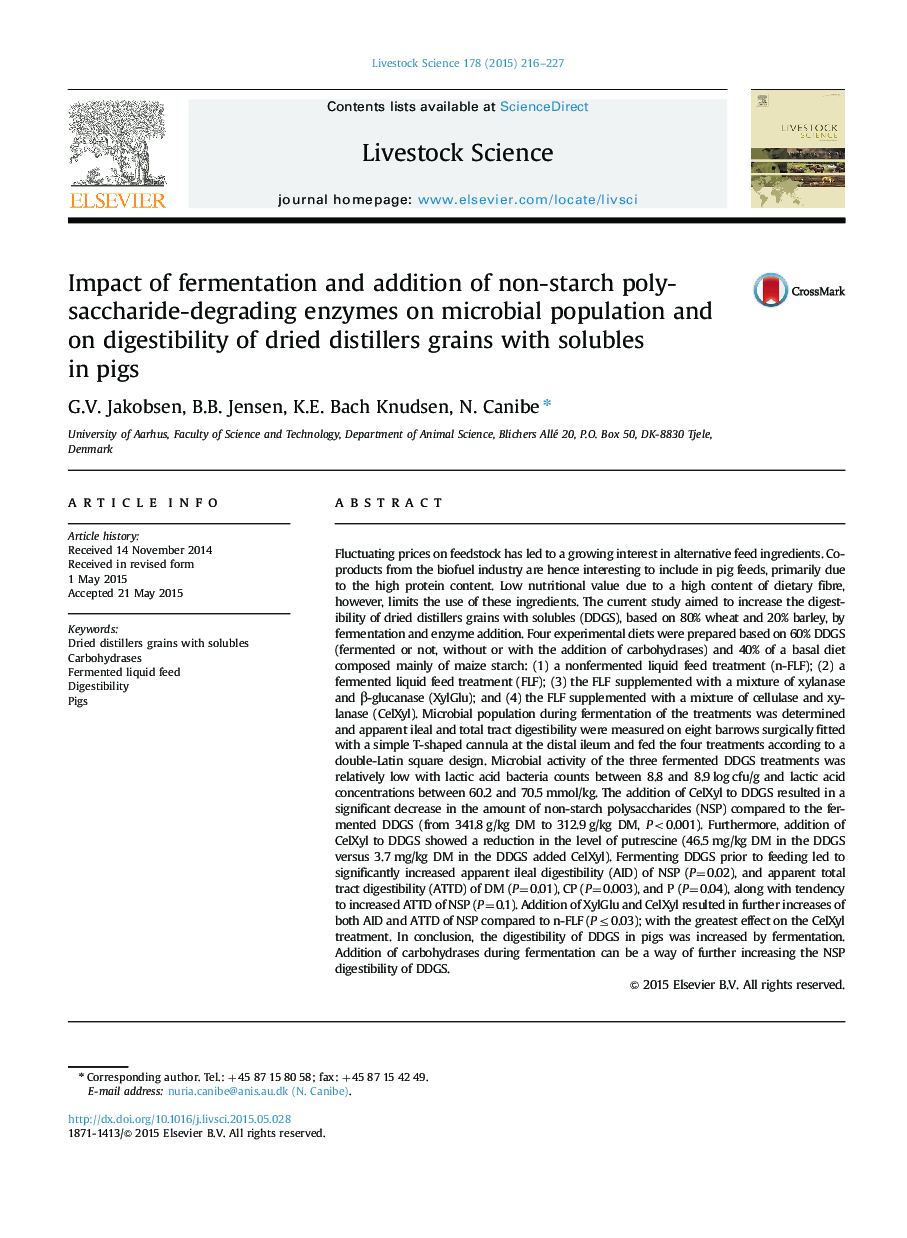| کد مقاله | کد نشریه | سال انتشار | مقاله انگلیسی | نسخه تمام متن |
|---|---|---|---|---|
| 2447080 | 1553954 | 2015 | 12 صفحه PDF | دانلود رایگان |
• Fermenting DDGS resulted in a low microbial activity compared to compound feed.
• Addition of an enzyme mixture reduced the concentration of NSP in DDGS.
• Fermentation resulted in increased digestibility of DM, CP, P and NSP.
• Addition of enzymes during fermentation further increased digestibility of NSP.
Fluctuating prices on feedstock has led to a growing interest in alternative feed ingredients. Co-products from the biofuel industry are hence interesting to include in pig feeds, primarily due to the high protein content. Low nutritional value due to a high content of dietary fibre, however, limits the use of these ingredients. The current study aimed to increase the digestibility of dried distillers grains with solubles (DDGS), based on 80% wheat and 20% barley, by fermentation and enzyme addition. Four experimental diets were prepared based on 60% DDGS (fermented or not, without or with the addition of carbohydrases) and 40% of a basal diet composed mainly of maize starch: (1) a nonfermented liquid feed treatment (n-FLF); (2) a fermented liquid feed treatment (FLF); (3) the FLF supplemented with a mixture of xylanase and β-glucanase (XylGlu); and (4) the FLF supplemented with a mixture of cellulase and xylanase (CelXyl). Microbial population during fermentation of the treatments was determined and apparent ileal and total tract digestibility were measured on eight barrows surgically fitted with a simple T-shaped cannula at the distal ileum and fed the four treatments according to a double-Latin square design. Microbial activity of the three fermented DDGS treatments was relatively low with lactic acid bacteria counts between 8.8 and 8.9 log cfu/g and lactic acid concentrations between 60.2 and 70.5 mmol/kg. The addition of CelXyl to DDGS resulted in a significant decrease in the amount of non-starch polysaccharides (NSP) compared to the fermented DDGS (from 341.8 g/kg DM to 312.9 g/kg DM, P<0.001). Furthermore, addition of CelXyl to DDGS showed a reduction in the level of putrescine (46.5 mg/kg DM in the DDGS versus 3.7 mg/kg DM in the DDGS added CelXyl). Fermenting DDGS prior to feeding led to significantly increased apparent ileal digestibility (AID) of NSP (P=0.02), and apparent total tract digestibility (ATTD) of DM (P=0.01), CP (P=0.003), and P (P=0.04), along with tendency to increased ATTD of NSP (P=0.1). Addition of XylGlu and CelXyl resulted in further increases of both AID and ATTD of NSP compared to n-FLF (P≤0.03); with the greatest effect on the CelXyl treatment. In conclusion, the digestibility of DDGS in pigs was increased by fermentation. Addition of carbohydrases during fermentation can be a way of further increasing the NSP digestibility of DDGS.
Journal: Livestock Science - Volume 178, August 2015, Pages 216–227
